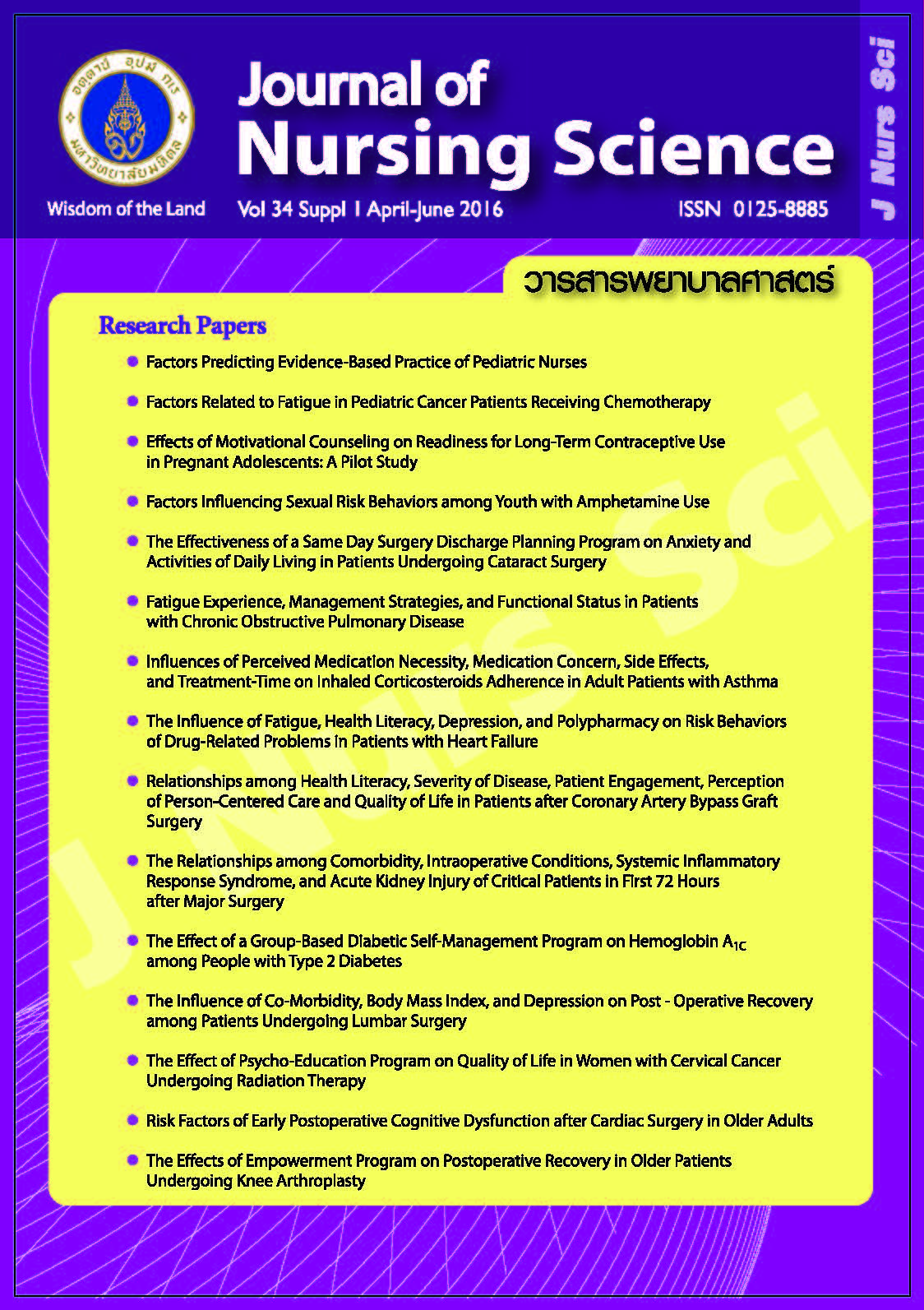Factors Related to Fatigue in Pediatric Cancer Patients Receiving Chemotherapy
Main Article Content
Abstract
Abstract
Purpose: To examine the relationships between age, sleep disturbance, nausea/vomiting, hematocrit level and fatigue in pediatric cancer patients, who received chemotherapy.
Design: Correlational descriptive design.
Methods: The study sample were 66 pediatric cancer patients aged 7-15 years who were treated with chemotherapy at the Pediatric Department of three tertiary care government hospitals; and were convenience recruited. Data were collected using questionnaires including the demographic data form, the sleep disturbance questionnaire, the nausea/vomiting questionnaire and the fatigue questionnaire. Data were analyzed with descriptive statistics and Pearson’s product moment correlation coefficient.
Main findings: The study findings revealed that age and hematocrit level were not correlated with fatigue (r = - .008, p > .05, r = .034, p > .05, respectively). Sleep disturbance and nausea/ vomiting were statistically significant correlated with fatigue (r = .609, p < .05, r = .40, p < .05, respectively).
Conclusion and recommendations: Healthcare providers, especially nurses, should recognize the importance of symptoms of sleep disturbance and nausea/vomiting in order to relieve fatigue of pediatric patients who were treated with chemotherapy. Nurses should also advise families about fatigue, related factors, and strategies of dealing with fatigue in order to provide effective care for pediatric cancer patients receiving chemotherapy.
ปัจจัยที่มีความสัมพันธ์กับอาการอ่อนล้าในผู้ป่วยเด็กโรคมะเร็งที่ได้รับยาเคมีบำบัด
บทคัดย่อ
วัตถุประสงค์: เพื่อศึกษาความสัมพันธ์ระหว่าง อายุ อาการนอนหลับแปรปรวน อาการคลื่นไส้อาเจียน และระดับฮีมาโตคริต กับอาการอ่อนล้าในผู้ป่วยเด็กโรคมะเร็งที่ได้รับยาเคมีบำบัด
รูปแบบการวิจัย: การศึกษาเชิงความสัมพันธ์
วิธีดำเนินการวิจัย: กลุ่มตัวอย่าง คือ ผู้ป่วยเด็กโรคมะเร็งอายุระหว่าง 7-15 ปี จำนวน 66 ราย ที่มารับการรักษาในแผนกกุมารเวชศาสตร์ โรงพยาบาลระดับตติยภูมิของรัฐ จำนวน 3 แห่ง ในกรุงเทพมหานคร รวบรวมข้อมูลโดยใช้แบบบันทึกข้อมูลส่วนบุคคล แบบประเมินอาการนอนหลับแปรปรวน แบบประเมินอาการคลื่นไส้อาเจียน และแบบประเมินอาการอ่อนล้า วิเคราะห์ข้อมูลโดยใช้สถิติเชิงพรรณนา และสถิติสหสัมพันธ์เพียร์สัน
ผลการวิจัย: ผลการศึกษาพบว่า อายุ และระดับฮีมาโตคริตไม่มีความสัมพันธ์กับอาการอ่อนล้า (r = - .008, p > .05 และ r = .034, p > .05 ตามลำดับ) ในขณะที่อาการนอนหลับแปรปรวนและอาการคล่นื ไส้อาเจียนมีความสัมพันธ์ทางบวกกับอาการอ่อนล้า (r = .609, p < .05 และ r = .40, p < .05 ตามลำดับ)
สรุปและข้อเสนอแนะ: บุคลากรทางการแพทย์โดยเฉพาะพยาบาล ควรตระหนักถึงความสำคัญของการวางแผนการจัดกิจกรรมการพยาบาลเพื่อจัดการกับอาการนอนหลับแปรปรวน และอาการคลื่นไส้อาเจียน ในการบรรเทาอาการอ่อนล้าที่เกิดขึ้นกับผู้ป่วยเด็ก ตลอดจนให้คำแนะนำครอบครัวเกี่ยวกับอาการอ่อนล้าปัจจัยที่ทำให้เกิดอาการอ่อนล้า และการจัดการกับอาการที่อ่อนล้าเกิดขึ้นเพื่อให้ครอบครัวให้การดูแลผู้ป่วยเด็กโรคมะเร็งที่ได้รับยาเคมีบำบัดได้อย่างมีประสิทธิภาพ
คำสำคัญ: ปัจจัยบางประการ อาการอ่อนล้า ผู้ป่วยเด็กโรคมะเร็ง ยาเคมีบำบัด
Article Details
Copyright Notice: Nursing Science Journal of Thailand has exclusive rights to publish and distribute the manuscript and all contents therein. Without the journal’s permission, the dissemination of the manuscript in another journal or online, and the reproduction of the manuscript for non-educational purpose are prohibited.

Disclaimer: The opinion expressed and figures provided in this journal, NSJT, are the sole responsibility of the authors. The editorial board bears no responsibility in this regard.


